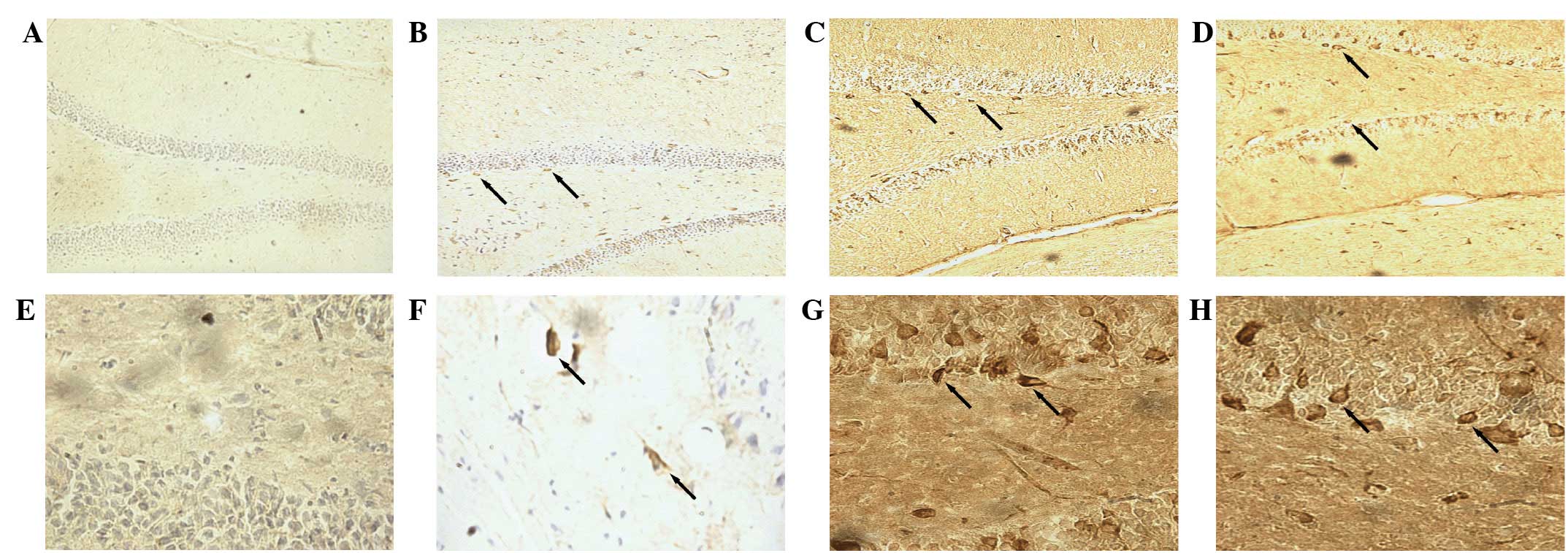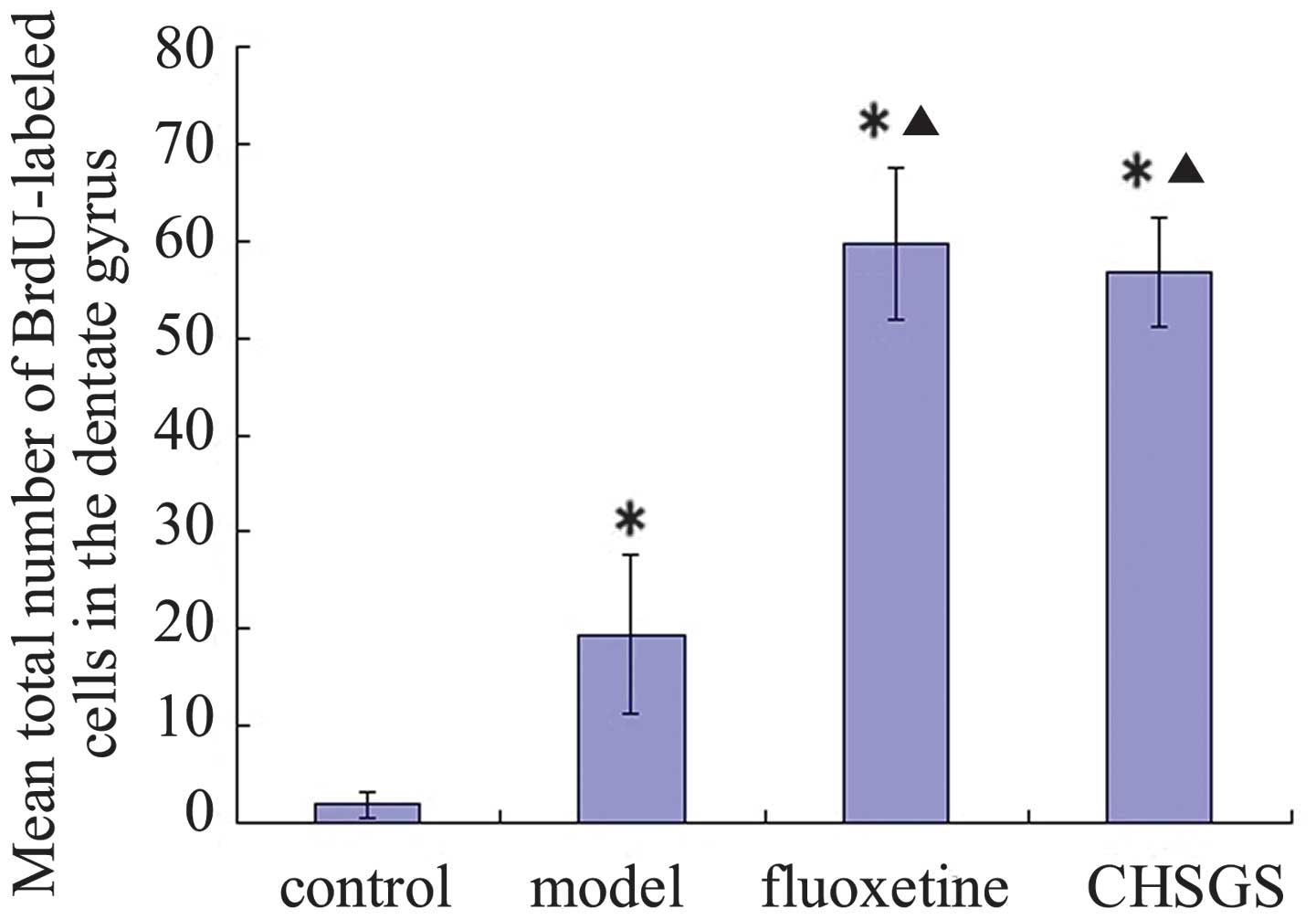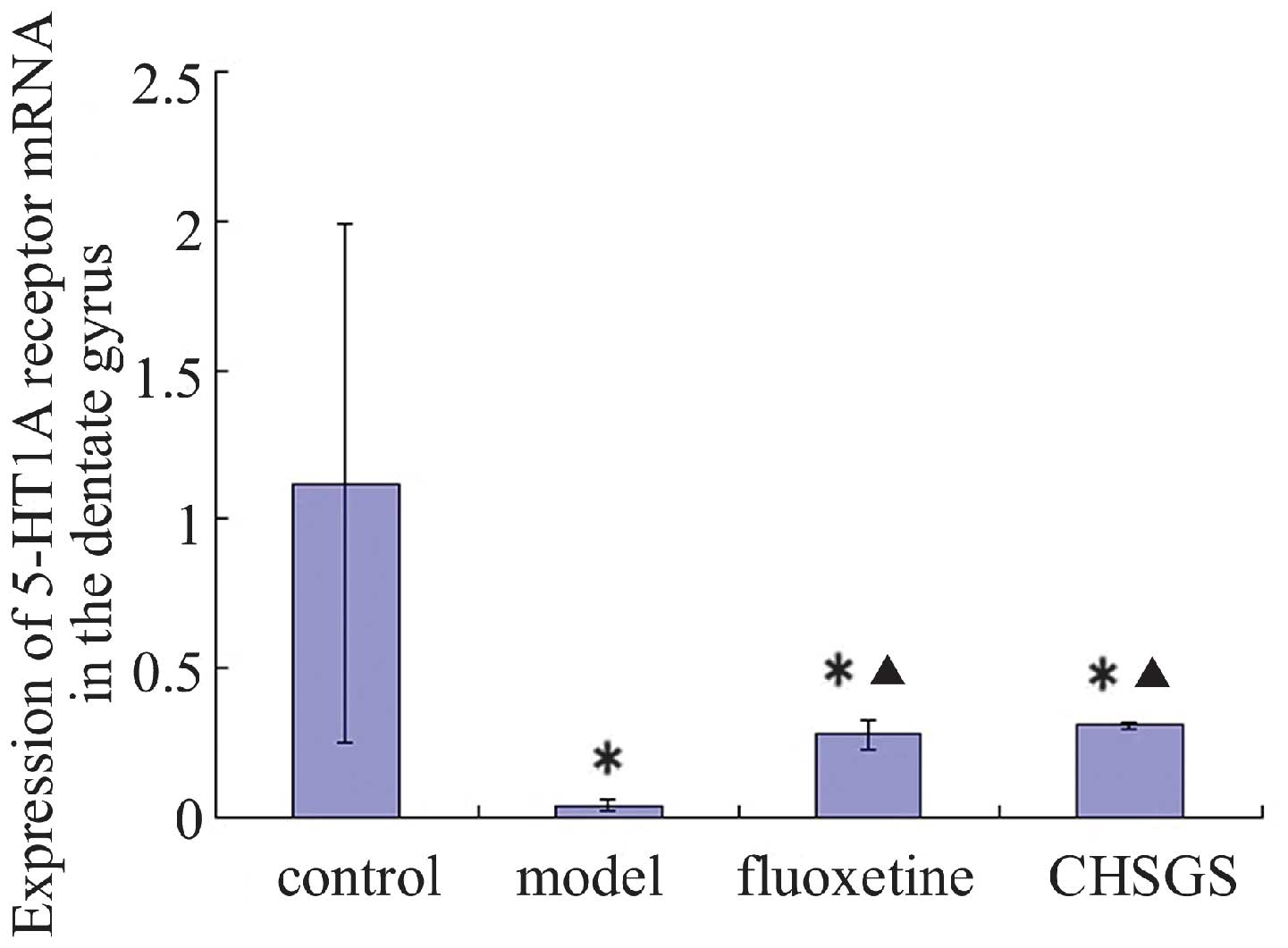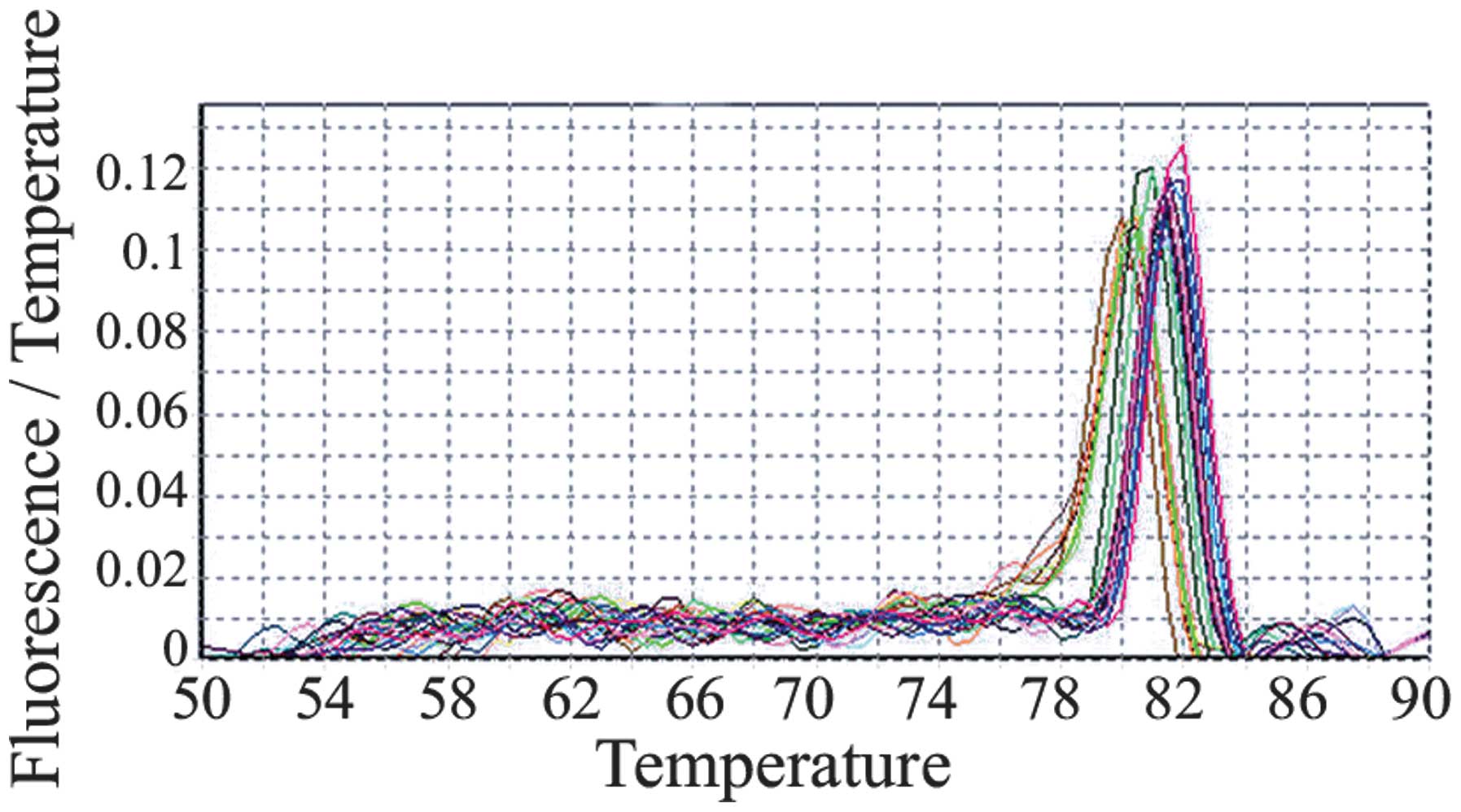|
1
|
Peng WF and Wang X: Comorbidity of
epilepsy and depression: From clinical to basic research. Shi Jie
Lin Chuang Yao Wu. 33:13–17. 2012.(In Chinese).
|
|
2
|
Pineda EA, Hensler JG, Sankar R, Shin D,
Burke TF and Mazarati AM: Plasticity of presynaptic and
postsynaptic serotonin 1A receptors in an animal model of
epilepsy-associated depression. Neuropsychopharmacology.
36:1305–1316. 2011. View Article : Google Scholar : PubMed/NCBI
|
|
3
|
Theodore WH, Wiggs EA, Martinez AR, Dustin
IH, Khan OI, Appel S, Reeves-Tyer P and Sato S: Serotonin 1A
receptors, depression, and memory in temporal lobe epilepsy.
Epilepsia. 53:129–133. 2012. View Article : Google Scholar : PubMed/NCBI
|
|
4
|
Yang P, Sun MZ, Li L and Shen YH:
8-hydroxy-dipropylaminotetralin promotes neural plasticity in
epileptic rats with depression. Neural Regen Res. 7:565–571.
2012.PubMed/NCBI
|
|
5
|
Al-Abri SA, Orengo JP, Hayashi S, Thoren
KL, Benowitz NL and Olson KR: Delayed bupropion cardiotoxicity
associated with elevated serum concentrations of bupropion but not
hydroxybupropion. Clin Toxicol (Phila). 51:1230–1234. 2013.
View Article : Google Scholar : PubMed/NCBI
|
|
6
|
Wang S, Hu SY, Zhang CH, Qiu J and Li YH:
Antidepressant-like activity of Chaihu-Shugan-San aqueous extract
in rats and its possible mechanism. Pharmacogn Mag. 10(Suppl 1):
S50–S56. 2014. View Article : Google Scholar : PubMed/NCBI
|
|
7
|
The Ministry of Science and Technology of
the People's Republic of China: Guidance Suggestions for the Care
and Use of Laboratory Animals. Beijing: 2006.
|
|
8
|
Chinese Pharmacopoeia Commission:
Pharmacopoeia of the People's Republic of China. 1:(10th).
(Beijing). Chinese Medical Science and Technology Press. 38–263.
2010.
|
|
9
|
Tan YZ: Pharmacology Experiment. Beijing:
People's Medical Publishing House. 141–142. 2008.
|
|
10
|
Wang SH, Zhang ZJ, Guo YJ, Teng AJ and
Chen BA: Expression of 5-hydroxytryptamine 1A receptor protein and
message RNA in the dentate gyrus in post-stroke depression rats.
Zhong Hua Jing Shen Ke Za Zhi. 41:107–110. 2008.(In Chinese).
|
|
11
|
Meng H, Wang Y, Huang M, Lin W, Wang S and
Zhang B: Chronic deep brain stimulation of the lateral habenula
nucleus in a rat model of depression. Brain Res. 1422:32–38. 2011.
View Article : Google Scholar : PubMed/NCBI
|
|
12
|
Racine RJ: Modification of seizure
activity by electrical stimulation. II. Motor seizure.
Electroencephalogr Clin Neurophysiol. 32:281–294. 1972. View Article : Google Scholar : PubMed/NCBI
|
|
13
|
Wang SH, Zhang ZJ, Guo YJ, Sui YX and Sun
Y: Notch1 signaling related hippocampal neurogenesis in adult
poststroke depression rats: A valid index for an efficient combined
citalopram and WAY100635 pharmacotherapy. Behav Pharmacol.
21:47–57. 2010. View Article : Google Scholar : PubMed/NCBI
|
|
14
|
Zhou Y, Liu M and Liang WN: Progress on
the epidemiological study of epilepsy. Zhonghua Liu Xing Bing Xue
Za Zhi. 28:92–94. 2007.(In Chinese). PubMed/NCBI
|
|
15
|
Lacey CJ, Salzberg MR and D'Souza WJ: Risk
factors for depression in community-treated epilepsy: Systematic
review. Epilepsy Behav. 43:1–7. 2015. View Article : Google Scholar : PubMed/NCBI
|
|
16
|
Fiest KM, Dykeman J, Patten SB, Wiebe S,
Kaplan GG, Maxwell CJ, Bulloch AG and Jette N: Depression in
epilepsy: A systematic review and meta-analysis. Neurology.
80:590–599. 2013. View Article : Google Scholar : PubMed/NCBI
|
|
17
|
Zhao YL and Yang X: Comparative
observation on synergistic effect of tandospirone antidepressant.
Lin Chuang Jing Shen Yi Xue Za Zhi. 18:402008.(In Chinese).
|
|
18
|
Mago R, Mahajan R and Thase ME: Medically
serious adverse effects of newer antidepressants. Curr Psychiatry
Rep. 10:249–257. 2008. View Article : Google Scholar : PubMed/NCBI
|
|
19
|
Ma L and Wu HF: A case of epileptic state
caused by fluoxetine. Lin Chuang Wu Zhen Wu Zhi. 21:802008.(In
Chinese).
|
|
20
|
Pineda EA, Hensler JG, Sankar R, Shin D,
Burke TF and Mazarati AM: Interleukin-1β causes fluoxetine
resistance in an animal model of epilepsy-associated depression.
Neurotherapeutics. 9:477–485. 2012. View Article : Google Scholar : PubMed/NCBI
|
|
21
|
Jiang GQ, Wang JM, Fan MY, Lv JJ and Zhang
HK: Progress on pathogenesis and treatment of epilepsy with
depression in integrative medicine. Zhong Xi Yi Jie He Xin Nao Xue
Guan Bing Za Zhi. 9:1247–1249. 2011.(In Chinese).
|
|
22
|
Cao MQ, Chen DH, Zhang CH and Wu ZZ:
Screening of specific microRNA in hippocampus of depression model
rats and intervention effect of Chaihu Shugan San. Zhongguo Zhong
Yao Za Zhi. 38:1585–1589. 2013.(In Chinese). PubMed/NCBI
|
|
23
|
Deng Y, Zhang CH and Zhang HN: Effects of
chaihu shugan powder on the behavior and expressions of BDNF and
TrkB in the hippocampus, amygdala and the frontal lobe in rat model
of depression. Zhongguo Zhong Xi Yi Jie He Za Zhi. 31:1373–1378.
2011.(In Chinese). PubMed/NCBI
|
|
24
|
Wang S, Hu S, Zhang C, Qiu J and Li Y:
Effect of Chaihu Shugan San and its components on expression of
ERK1/2 mRNA in the hippocampus of rats with chronic mild
unpredicted stress depression. Zhong Nan Da Xue Xue Bao Yi Xue Ban.
36:93–100. 2011.(In Chinese). PubMed/NCBI
|
|
25
|
Huang YS, Zhuo Y and Liu ZL: Effect of
Chaihu-Shugan-San on expression of bc1–2 and bax in
cardiazole-induced epileptic rats' hippocampus and frontal cortex.
Zhonghua Lin Chuang Yi Shi Za Zhi (Dian Zi Ban). 6:1574–1575.
2012.(In Chinese).
|
|
26
|
Xie W, Shi GJ, Li CZ, Bao Y, Yu L, Yu YH
and Du NN: Effect of Chaihu Shugan Tang on electroencephalogram and
expression of multidrug resistance protein p-glycoprotein of
refractory epilepsy. Zhong Guo Shi Yan Fang Ji Xue Za Zhi.
17:128–131. 2011.(In Chinese).
|
|
27
|
Liu J and Zhong C: 40 cases of post-stroke
depression treated by Chaihu-Shugan-San. Zhong Guo Zhong Yi Ji
Zheng. 21:7882012.(In Chinese).
|
|
28
|
Zou LH, Li H, Zeng ZQ, Chen XD and Deng
ZH: Chaihu Shugan powder combined with venlafaxine for treatment of
post-stroke depression. Zhong Xi Yi Jie He Xin Nao Xue Guan Bing Za
Zhi. 9:1330–1332. 2011.(In Chinese).
|
|
29
|
Wang Y, Fan R and Huang X: Meta-analysis
of the clinical effectiveness of traditional Chinese medicine
formula Chaihu-Shugan-San in depression. J Ethnopharmacol.
141:571–577. 2012. View Article : Google Scholar : PubMed/NCBI
|
|
30
|
Kanner AM: Depression and epilepsy: A
bidirectional relation? Epilepsia. 52(Suppl 1): S21–S27. 2011.
View Article : Google Scholar
|
|
31
|
Hasler G, Bonwetsch R, Giovacchini G,
Toczek MT, Bagic A, Luckenbaugh DA, Drevets WC and Theodore WH:
5-HT1A receptor binding in temporal lobe epilepsy patients with and
without major depression. Biol Psychiatry. 62:1258–1264. 2007.
View Article : Google Scholar : PubMed/NCBI
|
|
32
|
Covic M, Karaca E and Lie DC: Epigenetic
regulation of neurogenesis in the adult hippocampus. Heredity
(Edinb). 105:122–134. 2010. View Article : Google Scholar : PubMed/NCBI
|
|
33
|
Ming GL and Song H: Adult neurogenesis in
the mammalian brain: Significant answers and significant questions.
Neuron. 70:687–702. 2011. View Article : Google Scholar : PubMed/NCBI
|
|
34
|
Taciany Bonassoli V, Micheli Chassot J,
Longhini R, Milani H, Mello JC and de Oliveira RM: Subchronic
administration of Trichilia catigua ethyl-acetate fraction
promotes antidepressant-like effects and increases hippocampal cell
proliferation in mice. J Ethnopharmacol. 143:179–184. 2012.
View Article : Google Scholar : PubMed/NCBI
|
|
35
|
Radley JJ and Jacobs BL:
Pilocarpine-induced status epilepticus increases cell proliferation
in the dentate gyrus of adult rats via a 5-HT1A receptor-dependent
mechanism. Brain Res. 966:1–12. 2003. View Article : Google Scholar : PubMed/NCBI
|



















